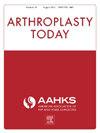Improved Walking Steadiness Following total Hip Arthroplasty Compared to Total Knee Arthroplasty
IF 2.1
Q3 ORTHOPEDICS
引用次数: 0
Abstract
Background
Total knee (TKA) and hip arthroplasty (THA) effectively treat end-stage osteoarthritis by restoring mobility and reducing pain; however, it is unclear how balance and steadiness compare between TKA and THA patients. This study utilized wearable technology to objectively compare functional recovery between TKA and THA patients.
Methods
Two Hundred Nine patients underwent TKA (n = 152) or THA (n = 57) and were followed for 1 year. Participants wore Apple Watches with HealthKit to track daily step count, steadiness, standing duration, gait speed, and estimated 6-minute walk test distance. Data were analyzed at baseline, 6 weeks, 6 months, and 12 months postsurgery. Propensity score matching (1:1 ratio) yielded a final cohort of 110 patients (55 TKA, 55 THA). A multivariate regression analysis was conducted to evaluate the effect of THA vs TKA on steadiness, adjusting for contralateral Kellgren–Lawrence classification, age, sex, and body mass index.
Results
Both groups improved mobility and endurance, with similar increases in step count, standing duration, and 6-minute walk test distance over 12 months. THA patients showed significantly greater steadiness at 6 (0.63 vs 0.49, P = .031) and 12 months (0.84 vs 0.66, P = .044). Multivariate analysis confirmed that TKA was associated with lower steadiness scores.
Conclusions
This study, the first to utilize Apple HealthKit data to compare TKA and THA recovery, found that THA patients exhibit better steadiness and balance recovery at 6 and 12 months. These findings suggest that balance-focused rehabilitation may benefit TKA patients. Wearable technology provides valuable, objective insights, enabling personalized guidance and enhancing patient outcomes.
与全膝关节置换术相比,全髋关节置换术后行走稳定性的改善
背景:全膝关节(TKA)和髋关节置换术(THA)通过恢复活动能力和减轻疼痛有效治疗终末期骨关节炎;然而,尚不清楚TKA和THA患者的平衡性和稳定性如何比较。本研究利用可穿戴技术客观比较TKA和THA患者的功能恢复情况。方法239例患者行TKA(152例)或THA(57例),随访1年。参与者佩戴带有HealthKit的苹果手表,跟踪每天的步数、稳定性、站立时间、步态速度和估计的6分钟步行测试距离。在基线、术后6周、6个月和12个月分析数据。倾向评分匹配(1:1比例)产生了110例患者的最终队列(55例TKA, 55例THA)。采用多元回归分析评估THA与TKA对稳定性的影响,调整对侧Kellgren-Lawrence分类、年龄、性别和体重指数。结果在12个月的时间里,两组患者的活动能力和耐力都有所提高,步数、站立时间和6分钟步行测试距离都有相似的增加。THA患者在6个月(0.63 vs 0.49, P = 0.031)和12个月(0.84 vs 0.66, P = 0.044)时表现出更大的稳定性。多变量分析证实TKA与较低的稳定性评分相关。本研究首次利用Apple HealthKit数据比较全髋关节置换术和全髋关节置换术的恢复情况,发现全髋关节置换术患者在6个月和12个月时表现出更好的稳定性和平衡恢复。这些发现表明以平衡为中心的康复可能对TKA患者有益。可穿戴技术提供了有价值的、客观的见解,实现了个性化指导,提高了患者的治疗效果。
本文章由计算机程序翻译,如有差异,请以英文原文为准。
求助全文
约1分钟内获得全文
求助全文
来源期刊

Arthroplasty Today
Medicine-Surgery
CiteScore
2.90
自引率
0.00%
发文量
258
审稿时长
40 weeks
期刊介绍:
Arthroplasty Today is a companion journal to the Journal of Arthroplasty. The journal Arthroplasty Today brings together the clinical and scientific foundations for joint replacement of the hip and knee in an open-access, online format. Arthroplasty Today solicits manuscripts of the highest quality from all areas of scientific endeavor that relate to joint replacement or the treatment of its complications, including those dealing with patient outcomes, economic and policy issues, prosthetic design, biomechanics, biomaterials, and biologic response to arthroplasty. The journal focuses on case reports. It is the purpose of Arthroplasty Today to present material to practicing orthopaedic surgeons that will keep them abreast of developments in the field, prove useful in the care of patients, and aid in understanding the scientific foundation of this subspecialty area of joint replacement. The international members of the Editorial Board provide a worldwide perspective for the journal''s area of interest. Their participation ensures that each issue of Arthroplasty Today provides the reader with timely, peer-reviewed articles of the highest quality.
 求助内容:
求助内容: 应助结果提醒方式:
应助结果提醒方式:


